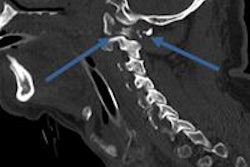
GRAPEVINE, TX - A digital image sharing system can yield critical improvements for managing imaging studies on CD/DVDs from trauma transfer patients, according to a presentation on Friday at the Society for Imaging Informatics in Medicine (SIIM) annual meeting.
After implementing a new workflow based on a digital image sharing system to import CD/DVD images, the University of Maryland's R. Adams Cowley Shock Trauma Center realized a significant reduction in repeat imaging studies and improvements in enterprise-wide image distribution and efficiency, said PACS team manager Michael Toland. Toland described the approach during a scientific session at SIIM 2013.
The Shock Trauma Center received more than 2,400 patient transfers from area hospitals during its 2012 fiscal year. Many trauma patients come with medical imaging as part of the transfer process, but the center didn't have a strong, consistent workflow for handling outside exams, Toland said. Supporting documentation was also often missing.
This poor workflow can lead to issues such as repeat imaging exams, additional radiation exposure, and more time expended during the critical "golden hour" treatment period, according to Toland.
The center had previously used a film library to import trauma transfer images from CD/DVDs. But the process wasn't fast enough and the film library was staffed only during normal business hours. It also utilized paper-driven workflow.
A new approach
The institution sought to develop a new workflow model that could provide fast, easy ingestion of CD/DVD media while upholding standard requirements for data integrity. It was also crucial to have a system that could be operated by the clinical staff in the trauma area, as time is of the essence with these patients, he said.
The University of Maryland team developed a new workflow process with seven steps:
- Trauma patient arrives with CD/DVD
- Trauma nurse uploads the CD to the digital image sharing system (LifeImage)
- Trauma clinician reviews study in the digital image sharing system
- Trauma clinician orders "Trauma Outside Consult" in the hospital information system
- Technologist schedules the order in the RIS
- Trauma radiologist is notified of the pending consult and sends the study to the PACS from the digital image sharing system
- Trauma radiologist reads the exam(s) on PACS, using the standard radiology workflow for exam interpretation (RIS, PACS, speech recognition)
After implementing the system in late 2011, the new workflow led to a significant increase in trauma patient exams being uploaded into PACS. There's also been a rapid drop-off of studies via the old method of importing images into PACS from the film library.
"Largely this has pretty much trickled down to nothing," he said.
About 60% of the exams that come into the image sharing system are being sent over to the production PACS and follow the normal radiology workflow for an outside trauma consult, Toland said. Trauma clinicians did not ask for a consult on the remaining cases.
Fewer repeat exams
The new process has decreased the number of repeat exams being performed, Toland said. There have also been fewer patient complications related to contrast for transfer patients.
"The efficiency of CT resources has been greatly improved," he said.
The new approach also facilitates enterprise image distribution. Trauma transfer images are now included in the patient record with a radiologist report and are available as relevant prior study.
In addition, the new system has enabled analytics of new data on outside imaging, such as volume, referring site analysis, and trends. It also allows for improved documentation, with an official radiology consultation utilizing the standard radiology workflow, he said.
The center's film library is also more efficient because it no longer has to import CD/DVDs from trauma patients.
Keys for success
Successful handling of trauma patient image CD/DVDs requires a workflow that can quickly ingest outside image data while ensuring data integrity, Toland said. It's also important for clinical users to drive the workflow without having to involve IT, support staff, or the film library.
"It should be viewed as a clinical tool," he said.
The system should also have a minimal effect on clinical duties, providing a streamlined workflow using the new technology.
The new workflow positions the center for the future of cloud-based image transfer, Toland noted.
"In trauma, we're starting to see a lot of sites that transfer to us wanting to stop sending CDs and start transferring through the cloud," he said. "I think that's going to take off in the very near future."
Solving the trauma image transfer issue first also sets a great precedent to tackle image sharing scenarios encountered in other departments, Toland said.



















